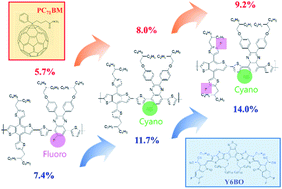High performance cyano-substituted quinoxaline-based polymers for both fullerene and nonfullerene polymer solar cells†
Abstract
To investigate the effect of the electron-withdrawing cyano (CN) substituent on the photovoltaic properties of polymers, three quinoxaline (Qx)-based polymers are designed and synthesized. The reference polymer (PTB-FQx) was prepared via polymerization between benzodithiophene (BDT) and mono-fluorinated Qx monomers, and the fluorine atom of PTB-FQx was replaced by a CN substituent to create the target polymer PTB-CNQx. In addition, another target polymer PTBF-CNQx was prepared by incorporating additional fluorine atoms on the two thiophene side chains of the BDT unit in PTB-CNQx. The photovoltaic performances of all polymers were comprehensively examined by fabricating both fullerene and nonfullerene polymer solar cells (PSCs). Owing to the affirmative contributions of the CN substituent, PSCs based on CN-substituted PTB-CNQx exhibit higher power conversion efficiencies (PCEs) than the corresponding devices with the fluorinated PTB-FQx reference. Moreover, further increases in the PCE of up to 9.2 and 14.0% were achieved for the devices based on PTBF-CNQx with fullerene and nonfullerene acceptors, respectively. To the best of our knowledge, this study can offer not only the first direct comparison of the photovoltaic properties of the F and CN substituents of conjugated polymers but also the highest PCEs among the reported CN-substituted polymers in both categories of fullerene and nonfullerene PSCs.



 Please wait while we load your content...
Please wait while we load your content...